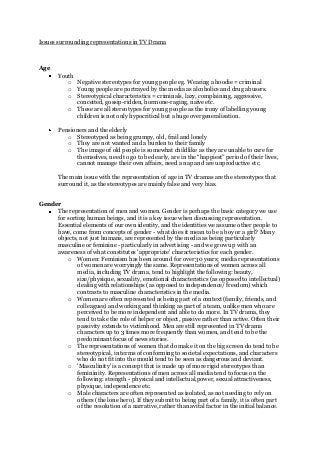
Issues surrounding representations in TV drama
- 1. Issues surrounding representations in TV Drama Age Youth o Negative stereotypes for young people eg. Wearing a hoodie = criminal o Young people are portrayed by the media as alcoholics and drug abusers. o Stereotypical characteristics = criminals, lazy, complaining, aggressive, conceited, gossip-ridden, hormone-raging, naïve etc. o These are all stereotypes for young people as the irony of labelling young children is not only hypocritical but a huge overgeneralisation. Pensioners and the elderly o Stereotyped as being grumpy, old, frail and lonely o They are not wanted and a burden to their family o The image of old people is somewhat childlike as they are unable to care for themselves, need to go to bed early, are in the “happiest” period of their lives, cannot manage their own affairs, need a nap and are unproductive etc. The main issue with the representation of age in TV dramas are the stereotypes that surround it, as the stereotypes are mainly false and very bias. Gender The representation of men and women. Gender is perhaps the basic category we use for sorting human beings, and it is a key issue when discussing representation. Essential elements of our own identity, and the identities we assume other people to have, come from concepts of gender - what does it mean to be a boy or a girl? Many objects, not just humans, are represented by the media as being particularly masculine or feminine - particularly in advertising - and we grow up with an awareness of what constitutes 'appropriate' characteristics for each gender. o Women: Feminism has been around for over 30 years; media representations of women are worryingly the same. Representations of women across all media, including TV drama, tend to highlight the following: beauty, size/physique, sexuality, emotional characteristics (as opposed to intellectual) dealing with relationships (as opposed to independence/ freedom) which contrasts to masculine characteristics in the media. o Women are often represented as being part of a context (family, friends, and colleagues) and working and thinking as part of a team, unlike men who are perceived to be more independent and able to do more. In TV drama, they tend to take the role of helper or object, passive rather than active. Often their passivity extends to victimhood. Men are still represented in TV drama characters up to 3 times more frequently than women, and tend to be the predominant focus of news stories. o The representations of women that do make it on the big screen do tend to be stereotypical, in terms of conforming to societal expectations, and characters who do not fit into the mould tend to be seen as dangerous and deviant. o 'Masculinity' is a concept that is made up of more rigid stereotypes than femininity. Representations of men across all media tend to focus on the following: strength - physical and intellectual,power, sexual attractiveness, physique, independence etc. o Male characters are often represented as isolated, as not needing to rely on others (the lone hero). If they submit to being part of a family, it is often part of the resolution of a narrative, rather than avital factor in the initial balance.
- 2. It is interesting to note that the male physique is becoming more important a part of representations of masculinity. Race Ethnicity, like sex, is a set of genetically defined, biological characteristics. However, like gender, it is also a set of culturally defined characteristics. Representation of race in the media can consist of the same sort of rigid stereotypes that constitute gender portrayal. However, stereotyping of race is seen as more harmful than stereotyping of gender, as media representation may constitute the only experience of contact with a particular ethnic group that an audience (particularly an audience of children) may have. Racial stereotypes are often based on social myth, continued down the ages. Class Disability Regional identity This constitutes the representation of individuals from a certain geographical area. o Places to consider are London and New York. These cities are often portrayed in TV Dramas. Being someone who does not live in either of these cities you can base your ideas on who the people who live there are on depictions you have seen from television and film. This is why considering regional identity is important. This maybe the only way people can begin identifying with other from different areas in the country or world.